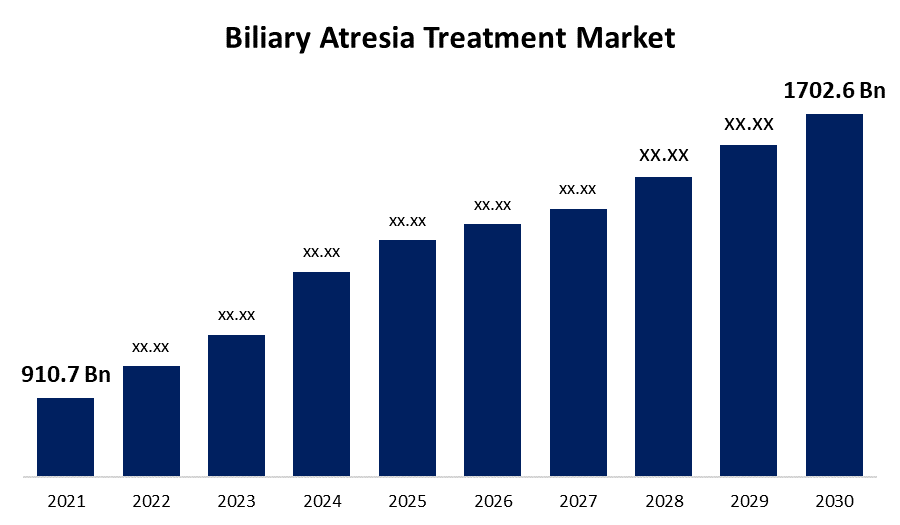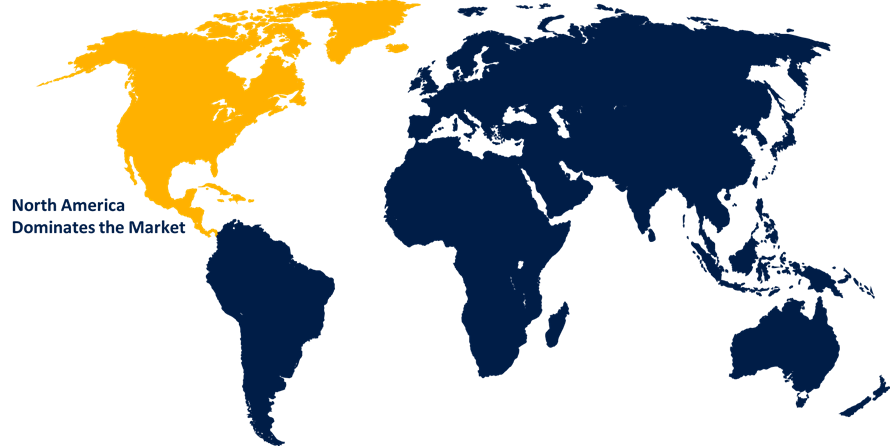Global Biliary Atresia Treatment Market Size, Share, and COVID-19 Impact Analysis By Disease Type (Type I, Type II, and Type III), By Drugs ( Corticosteroids, Bile Acids Analogues, Antibiotics, Others), By Route of Administration (Oral, Parenteral), By End-Users (Homecare, Hospitals, Specialty Clinics, Others), By Distribution Channel (Online Pharmacies, Hospital Pharmacies, Retail Pharmacies), and By Region (North America, Europe, Asia-Pacific, Latin America, Middle East, and Africa), Analysis and Forecast 2021 - 2030
Industry: HealthcareGlobal Biliary Atresia Treatment Market Insights Forecasts to 2030
- The global Biliary Atresia Treatment Market was valued at USD 910.7 billion in 2021.
- The market is growing at a CAGR of 7.2% from 2021 to 2030
- The global Biliary Atresia Treatment Market is expected to reach USD 1702.6 billion by 2030
- The Asia Pacific is expected to grow the fastest during the forecast period

Get more details on this report -
The global Biliary Atresia Treatment Market is expected to reach USD 1702.6 billion by 2030, at a CAGR of 7.2% during the forecast period 2021 to 2030. The biliary atresia treatment market is increasing due to the number of people diagnosed with biliary atresia, as well as an increase in the number of vulnerable elderly people all over the world. In addition, there has been an increase in the demand for novel treatments, which has also contributed to the growth of the biliary atresia treatment market.
Market Overview:
A liver disorder that can be developed over time is known as biliary atresia or extrahepatic ductopenia. This condition may be identified by the obliteration of the extrahepatic biliary system, which leads to a blockage in the passage of bile from the liver to the gall bladder. If treatment is not received at an early stage, this might result in liver damage or liver cirrhosis, both of which can be deadly. There is currently no explanation as to what causes biliary atresia to occur. On the other hand, several studies point to the possibility that infection with Reovirus 3, infection with congenital CMV, or a congenital abnormality can be the reason for the development of biliary atresia in humans. Symptoms of biliary atresia include pale diarrhea or the color of clay, jaundice, black urine, weight growth that is either very sluggish or nonexistent, mild hepatomegaly, and an enlarged spleen. Medications, such as bile acids, glucocorticoids, antibiotics, and surgical surgery, are all potential components of the therapy protocol. The Kasai technique, which successfully links the gut to the liver so that bile may flow, is the most common therapy method for this condition. Type I, also known as perinatal biliary atresia, type II, also known as biliary atresia splenic malformation, and type III, also known as cystic biliary atresia, are the three different types of biliary atresia.
Report Coverage
This research report categorizes the global biliary atresia treatment market based on various segments and regions, forecasts revenue growth, and analyzes trends in each submarket. The report analyses the key growth drivers, opportunities, and challenges influencing the global biliary atresia treatment-based market. Recent market developments and competitive strategies such as expansion, product launch and development, partnership, merger, and acquisition have been included to draw the competitive landscape in the market. The report strategically identifies and profiles the key market players and analyses their core competencies in each global biliary atresia treatment-based market sub-segments.
Global Biliary Atresia Treatment Market Report Coverage
| Report Coverage | Details |
|---|---|
| Base Year: | 2021 |
| Market Size in 2021: | USD 910.7 billion |
| Forecast Period: | 2021-2030 |
| Forecast Period CAGR 2021-2030 : | 7.2% |
| 2030 Value Projection: | USD 1702.6 billion |
| Historical Data for: | 2017-2020 |
| No. of Pages: | 240 |
| Tables, Charts & Figures: | 187 |
| Segments covered: | By Drugs, By End-Users, By Distribution Channel, By Region, COVID-19 Impact Analysis By Disease Type |
| Companies covered:: | Mylan N.V., Pfizer Inc., Novartis AG, AstraZeneca, Johnson & Johnson Private Limited, Sun Pharmaceutical Industries Ltd., Bristol-Myers Squibb Company, Lilly, Amgen Inc., Beckman Coulter Inc., Glenmark Pharmaceuticals Inc, Amneal Pharmaceuticals LLC. |
| Pitfalls & Challenges: | COVID-19 has the potential to impact the global market |
Get more details on this report -
Segmentation Analysis
- In 2021, the Type III segment dominated the market with the largest market share of 37% and market revenue of 336.9 billion.
Based on the disease type, the Biliary Atresia Treatment Market is categorized into Type I, Type II, and Type III. In 2021, the type III segment dominated the market with the largest market share of 37% and market revenue of 336.9 billion. Because of the relatively high prevalence of type III biliary atresia, the type III segment is anticipated to have the biggest market share in the worldwide biliary atresia treatment market during the forecast period. For instance, type III, also known as porta hepatis, is said to impact around 85–90% of individuals diagnosed with biliary atresia, as stated in an article by Science Direct published in 2016.
- In 2021, the Antibiotic segment accounted for the largest share of the market, with 28% and market revenue of 254.9 billion.
Based on drug type, the Biliary Atresia Treatment Market is categorized into Corticosteroids, Bile Acids Analogues, Antibiotics, and Others. In 2021, antibiotics dominated the market with the largest market share of 28% and market revenue of 254.9 billion. The antibiotic technique is the primary treatment for biliary atresia because there is no known cure for this disease. Antibiotic medication is utilized extensively during the Kasai procedure, expected to drive the segment’s growth.
- In 2021, the Parenteral segment dominated the market with the largest market share of 57% and market revenue of 519.0 billion.
Based on the route of administration, the Biliary Atresia Treatment Market is categorized as Oral and Parenteral. In 2021, the parenteral segment dominated the market with the largest market share of 57% and market revenue of 519.0 billion. The drug delivery done by the parenteral route is the quickest, easiest, and an effective way, which is why this segment dominates the market. Furthermore, the increasing cases of biliary atresia disease year by year, directly impact the growth of the parenteral drug delivery segment.
Regional Segment Analysis of the Biliary Atresia Treatment Market
- North America (U.S., Canada, Mexico)
- Europe (Germany, France, U.K., Italy, Spain, Rest of Europe)
- Asia-Pacific (China, Japan, India, Rest of APAC)
- South America (Brazil and the Rest of South America)
- The Middle East and Africa (UAE, South Africa, Rest of MEA)

Get more details on this report -
Among all regions, North America emerged as the largest market for the global Biliary Atresia Treatment Market, with a market share of around 36.4% and 910.7 billion of the market revenue in 2021.
- In 2021, North America emerged as the largest market for the global biliary atresia treatment market, with a market share of around 36.4% and 910.7 billion of the market revenue. The market for Biliary Atresia treatment is enhancing due to increased R&D activities. People in North America are very much aware of biliary atresia, which is also a factor in driving the market's growth in the region. Furthermore, the increasing awareness about biliary atresia treatment and advanced healthcare facilities in the region propel the growth of the market.
- The Asia Pacific market is expected to grow at the fastest CAGR between 2022 and 2030. The market for Biliary Atresia Treatment in the Asia Pacific region has been growing owing to the increasing government initiatives and the high prevalence rate of biliary atresia. The increasing demand for the treatment of biliary atresia is becoming a reason for the growth of the biliary atresia market in Asia- Pacific. There is also an advancement in the efficient medical devices in the region coupled with the increasing interest of people in taking care of elderly people at home with easy & simple products.
Competitive Analysis:
The report offers the appropriate analysis of the key organizations/companies involved within the global biliary atresia treatment market along with a comparative evaluation primarily based on their product offering, business overviews, geographic presence, enterprise strategies, segment market share, and SWOT analysis. The report also provides an elaborative analysis focusing on the current news and developments of the companies, which includes product development, innovations, joint ventures, partnerships, mergers & acquisitions, strategic alliances, and others. This allows for the evaluation of the overall competition within the market.
List of Key Market Players:
- F. Hoffmann-La Roche Ltd.
- Mylan N.V.
- Pfizer Inc.
- Novartis AG
- AstraZeneca
- Johnson & Johnson Private Limited
- Sun Pharmaceutical Industries Ltd.
- Bristol-Myers Squibb Company
- Lilly
- Amgen Inc.
- Beckman Coulter Inc.
- Glenmark Pharmaceuticals Inc
- Amneal Pharmaceuticals LLC.
Key Target Audience
- Market Players
- Investors
- End-users
- Government Authorities
- Consulting And Research Firm
- Venture capitalists
- Third-party knowledge providers
- Value-Added Resellers (VARs)
Recent Development
- In October 2021, pentoxifylline (PTX), a methylxanthine derivative, is through phase II of clinical trials. The purpose of the experiment is to establish whether or not PTX possesses a level of biological activity against biliary atresia.
- In September 2021, Maralixibat (LIVMARLI), an oral ileal bile acid transporter (IBAT) inhibitor, is in phase 2b of its clinical study for juvenile liver illnesses known as biliary atresia. This experiment is being conducted to determine the treatment’s efficacy.
Market Segment
This study forecasts revenue at global, regional, and country levels from 2019 to 2030. Spherical Insights has segmented the global biliary atresia treatment market based on the below-mentioned segments:
Global Biliary Atresia Treatment Market, By Disease Type
- Type I
- Type II
- Type III
Global Biliary Atresia Treatment Market, By Drugs Type
- Corticosteroids
- Bile Acids Analogues
- Antibiotics
- Others
Global Biliary Atresia Treatment Market, By Route of Administration
- Oral
- Parenteral
Global Biliary Atresia Treatment Market, By End-Users
- Homecare
- Hospitals
- Specialty Clinics
- Others
Global Biliary Atresia Treatment Market, By Distribution Channel
- Online Pharmacies
- Hospital Pharmacies
- Retail Pharmacies
Global Biliary Atresia Treatment Market Regional Analysis
- North America
- US
- Canada
- Mexico
- Europe
- Germany
- Uk
- France
- Italy
- Spain
- Russia
- Rest of Europe
- The Asia Pacific
- China
- Japan
- India
- South Korea
- Australia
- Rest of Asia Pacific
- South America
- Brazil
- Argentina
- Rest of South America
- Middle East & Africa
- UAE
- Saudi Arabia
- Qatar
- South Africa
- Rest of the Middle East & Africa
- Driver- Increase in the number of research and development activities
- Restraint- Complications of Biliary Atresia Drugs
- Opportunity- Increasing Demand for Retail Pharmacies
- Challenge- Unavailability of Appropriate Treatments
Frequently Asked Questions (FAQ)
-
What is the market size of the Biliary Atresia Treatment market?As per Spherical Insights, the size of the Biliary Atresia Treatment market was valued at USD USD 910.7 billion in 2021 to USD 1702.6 billion by 2030.
-
What is the market growth rate of the Biliary Atresia Treatment market?The Biliary Atresia Treatment market is growing at a CAGR of 7.2% from 2021 to 2030.
-
Which country dominates the Biliary Atresia Treatment market?North America emerged as the largest Biliary Atresia Treatment market.
-
Who are the key players in the Biliary Atresia Treatment market?Key players in the Biliary Atresia Treatment market are F. Hoffmann-La Roche Ltd., Mylan N.V., Pfizer Inc., Novartis AG, AstraZeneca, Johnson & Johnson Private Limited, Sun Pharmaceutical Industries Ltd., Bristol-Myers Squibb Company, Lilly, Amgen Inc., Beckman Coulter Inc., Glenmark Pharmaceuticals Inc, Amneal Pharmaceuticals LLC.
-
Which factor drives the growth of the Biliary Atresia Treatment market?An increase in the number of research and development activities drives the market's growth.
Need help to buy this report?